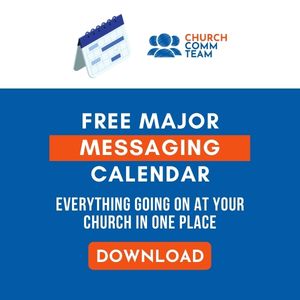[vc_row][vc_column][vc_column_text css=”.vc_custom_1505959021402{margin-bottom: 0px !important;}”]Ministry leaders are taught early on to say that our ministries aren’t “all about numbers,” but we all know that as soon as your program attendance drops below some magical benchmark you’ll start hearing the murmurs and the whispers asking “what’s going on?” And not in that smooth, reassuring Marvin Gaye kind of way, either.
While the danger of a fixation on numbers can be a whole other blog post, it is relevant here and I’ll tell you why.
Numbers are used to determine rewards and assests, and decisions are often made based on them. The attendence numbers in certain areas are often used to determine hiring and budgeting needs, but do not always reflect the actual needs. I’m going to give you four systems you need to put in place in your ministry whether you have 5 people coming or 5,000 and they may or may not require a rearrangement of the budget.
A Vision and Values System
Regardless of size, if you don’t know why you’re doing what your doing, chances are you’ll end up doing something irrelevant. Vision is the picture of what you see when everything is going right. Whether you have a few or a lot of people attending, you need to have a vision and I would suggest you write it down. Values are equally important because they are “how we achieve the vision.” At Fellowship Bible Church in Dallas, they have several values that determine how and what they will do as a church. Some of them are A Culture of Grace, Authentic Community, Missional Living, and Leaving a Legacy.
Without some guidelines built in to your ministry, you may find yourself running a ballet ministry that cannot be stopped (true story) or a 3 on 3 basketball ministry with enough players for 3 teams. My point is that without guidelines you could easily end up doing whatever the person screaming the loudest wants you to do. That’s not good leadership. That’s the tail wagging the dog.
Establish a values system and make sure it is posted somewhere that everyone can see it. After all, vision is only a dream until everyone agrees on it as a destination.
A Leadership System
I cannot stress the need for EVERYONE on staff or even lay leaders to be given a written job description. I would even go a step further and reduce it to one sentence like Andy Stanley does to make it super easy to remember. Job descriptions aren’t always followed to the letter, and that’s ok. But there should be some sort of anchor that answers the question “If all else fails, what am I supposed to do?”
I gave my small group leaders a job description once and it was a game changer: To pass on what I know and love about God to teenagers. Feel free to steal that and tweak it. I mean, don’t steal…but you can borrow it. Forever.
Everyone knowing what they are doing helps them to also know what they are NOT doing. This builds some respect for leadership over other areas of ministry and eliminates a lot of bleed over. You know that leader, right? The one who has all kinds of great ideas for your ministry but has no intention of helping you make any of them happen?
You also need an org chart for this reason. You don’t need to display this everywhere or anything, but staff members especially need to know who their boss is. The caution is for leaders to avoid trying to interfere directly with those who do not report to them directly. Sometimes you will have to do this, and depending on where you are in the org chart, that is your perrogative. However, save that card for when their boss has repeatedly failed to address the problem successfully, and even then, intervene with your direct report so as not to appear to undermine him/her.
Or you could just intervene all over the place, undermining everyone and causing all to curse your name forever.
A Communications System
First, let me just say, you need someone who has the final say over this area. You need someone who decides what gets communicated where and when. I recommend a gifted communications pastor (and no, there aren’t any 20 somethings out there with 15 years of experience, so get off it), or a staff member who understands the available mediums and how to use them (coughcoughyouthpastorcoughcough).
Second, there needs to be an understanding among staff and lay leaders what info goes where. Every single ministry will try to get their announcement made from the pulpit. Every. Single. One.
But here’s the hardcore truth: Not all announcements are created equal. *gasp
Write this criteria down and pass it round. It may include something like this: 1. No more than 2-3 announcements, a 5-minute maximum run time, and only all-church related announcements will be given on Sundays from the pulpit. 2. Mens/Womens ministry will go to facebook with a boost. 3. Youth will be given via email to parents, Instagram, and Snapchat. Etc.
Whatever you do, just make sure everyone knows how it’s going to work and protect it!
An Assimilation System
What is your ministry funnel? What the heck is a ministry funnel? I mean, what is the path for someone to go deeper into your ministry? What is at the center of the bulls-eye? Here’s an example:
I like to think of this like a house. When a visitor comes in, they come through the front door. The front door might be your website. (Ok, in this day and age, it’s definitely your web site.) Then they may come into the living room or sitting area. That’s your worship service. When we start to get to know each other, then we may have dinner together in the dining room. That’s your small groups. But soon, we want them to come in the kitchen and help us make dinner. That’s your serving wing.
See how it works? So, what programs or elements do you have going that help people to go deeper into the ministry of your church? What’s your ministry funnel?
Of course, once someone begins to actively serve, they are expected to go and bring them in through the front door and help them go deeper into the community of your ministry. The last phase of the funnel should always be teaching our people to repeat the process and bring in others.
It is also helpful to spell out the touch-points for each phase. For example, when visitors come to the service, what action do you want them to take? Fill out a guest card? Draw up a road map for deeper connection. It helps them feel like you have your stuff together and instills confidence in your ability to care for their family in the future.
Well, there you have it! No matter how mega or grassroots your ministry, these four systems are necessary to building a ministry that can grow, sustain itself, and reproduce disciples. I’ve probably forgotten something. What would you add to this list? Blow the whistle in the comments below!
[/vc_column_text][/vc_column][/vc_row]





Hey Seth
Your dad is my All Time favorite SS Teacher!!!
He would make a great interview
Love ya my Brother
Proud of you
Thanks, Alan! Good to hear from you!